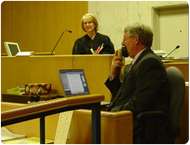Stenomask
A stenomask is a hand-held microphone built into a padded, sound-proof enclosure that fits over the speaker's mouth or nose and mouth. Some lightweight versions may be fitted with an elastic neck strap to hold them in place while freeing the user's hands for other tasks. The purpose of a stenomask is to allow a person to speak without being heard by other people, and to keep background noise away from the microphone.

A stenomask is useful for speech recognition applications, because it allows voice transcription in noisy environments. Perhaps more importantly, a stenomask silences the user's voice so that it does not interfere with the surrounding environment such as a court or a classroom. The user can verbally identify the speaker, indicate gestures and unspoken answers, and describe activities as they take place.[2]
An operator of a stenomask can be trained to "re-voice" everything he or she hears into a stenomask connected to a speech recognition system, for a real-time text transcription of everything spoken. This allows a "voice writer" to produce instant text feeds within a courtroom and distribute them in plain text format immediately after a proceeding. The equipment can also interface with litigation management software.
A trained operator using a stenomask connected to a pre-trained speech recognition system can exceed 180 words per minute while at the same time exceeding 95 percent accuracy. They may also modify the pronunciation of the words they are speaking in order to improve accuracy.
Microphones that work much like a stenomask are used by aircraft ground crews to communicate with cockpit crews in airport environments with extreme engine noise, and are usually part of their headsets.
History
The stenomask was developed by Horace Webb and two colleagues in the early 1940s. He was proficient with Gregg shorthand, but sought a more accurate and faster system of transcription, as shorthand notes can become unmanageable with fast talkers or difficult terminology. Furthermore, until recently, shorthand reporters would verbally dictate transcription notes into typewritten form, resulting in about two hours dictation for every hour transcribing.
Thus, Webb thought he could "repeat it with my voice instead of with a pen". After much experimentation — first with a cigar box and then a tomato juice can — he arrived at a solution using a microphone inside a military aviator's rubber oxygen mask, paired with a coffee pot filled with sound-absorbing material. The result was eventually deemed by the United States Navy to be the most accurate method of transcription among "all known systems of verbatim reporting", and was subsequently adopted for use in their court reporting.[3]
References
- "Wisconsin hires first Stenomask reporter [Archived 3/8/2012]". Archived from the original on March 8, 2012.CS1 maint: unfit url (link)
- Voice Writing: The Method Archived 2007-07-04 at the Wayback Machine, National Verbatim Reporters Assoc, retrieved 13 Mar 2007
- The Horace Webb Story Archived 2007-07-04 at the Wayback Machine, National Verbatim Reporters Assoc, retrieved 13 Mar 2007